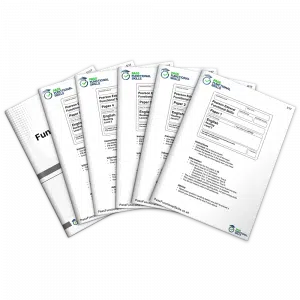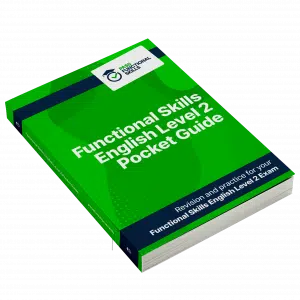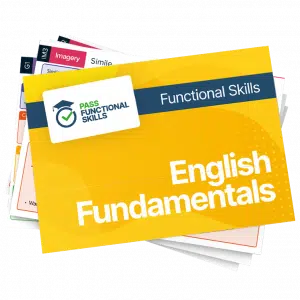Reading: Language Features
Language Features Functional Skills
Language features are perfect to add into your writing when you want to make it more exciting.
There are many different kinds, all of which have a special effect upon a text.
(There are even a few in this introduction! See if you can identify them by the end of this revision page…)


Special effects
Adding language features to a text is like adding spices to food!
Just as a good chef knows how to spice a dish perfectly, a good writer knows how to use language features to make the text as delicious to read as possible.
And, just like spices, language features go best with certain types of texts.
But, which is which?
Well, let’s take a look!
Some create imagery…
The writer can use language features to create images in the reader’s mind, creating a more vivid text.
These include:


Similes
A simile compares something to something else.
The writer will often use ‘as…as…‘ or ‘like‘ structures to create a simile.
For Example…
‘The task was as large and intimidating as a mountain.’
‘The client is like a dream to work with.’


Metaphors
A metaphor describes something by saying that it is something else.
They make the reader work a bit harder to make connections between the thing being described, and what it is being described as.
For Example…
‘Access to the best building material is gold dust.’
‘The meeting was a rollercoaster.’


Idioms
An idiom is a common saying that means something completely different to its literal meaning.
Idioms are great at creating very vivid images in the reader’s mind. This is because they are normally quite unusual and memorable.
As a result, they are useful when you want to simply represent a complex idea.
For Example…
‘I always wear rose tinted glasses when I think about that time.’
‘You seem absolutely over the moon!’
Follow Our Socials
Our Facebook page can put you in touch with other students of your course for revision and community support. Alternatively, you can find us on Instagram or TikTok where we're always sharing revision tips for all our courses.
Some affect the words themselves…
Some language features also impact the order or use of words themselves.
These include:


Alliteration
Alliteration is when a letter or sound is repeated at the beginning of a word.
However, alliteration can still be identified if it is separated by several words, phrases, or sentences.
The affect of alliteration is that the meaning of the word is emphasized.
In addition, the repeated letter sound itself influences how the reader interprets the text.
For Example:
”Passionate people pushed over the statue.”
”The passionate group pushed over the statue”
Can you see, in each of these examples, how the alliteration can be spread across both sentences and groups of sentences, in addition to being immediately next to each other?


Rule of 3
The rule of three is when the writer uses a group of three words or phrases together, therefore making the sentence itself more memorable and interesting.
When three things are put together, there is usually a good story to be found – think about the three little pigs and the three bears in the Goldilocks tale!


For Example:
”The worst, rainiest, cloudiest day I can remember was last Wednesday when I forgot to fill up my car and got stuck on the motorway.”
As you can see, this example with three words is much more effective than the alternative, with no rule of three…
‘The worst day I can remember was last Wednesday, when I forgot to fill up my car and got stuck on the motorway.”
”It is vital to make climate decisions for the people, by the people, of the people.”
Again, we can see that this example with three phrases is much more effective than the alternative, with no rule of three…
”It is vital to make climate decisions for the people.”


Repetition
Repetition is when words, phrases and even whole sentences are included in the text more than once.
Just like alliteration, they do not have to be placed directly next to each other to count, and as a result, repetition can have an impact on the whole text.
By repeating a word, phrase or sentence, the writer emphasizes what they are talking about, and impresses upon the reader its importance.
Repetition, as a result, is often used in advertising to help the consumer remember a particular product.
For Example:
”ActiveClean, your one stop shop for a sparkling house. ActiveClean.”
”Let it snow, let it snow, let it snow!”


Adjectives
Adjectives are describing words, and help to give more detail to a text.
Writers will often use adjectives when they want to add information to something or modify an idea, word, or phrase to make it more interesting and vivid for the reader.
For Example:
”When you have a difficult client, you may feel overwhelmed. Your stomach might get into knots, your head can become confused and fuzzy. Your usually spectacular memory may even become unreliable. All of these distressing symptoms are indicative of anxiety.”
”Rishi’s team management skills are truly outstanding, and we really wanted to take a moment this morning to reflect back some impressively positive feedback from his team.”
And some affect the reader…
Some language features are included by the writer specifically to impact the way the reader feels.
These include:


Rhetorical Questions
Rhetorical questions are questions which the writer asks, but does not expect or need an answer to.
Instead, the answer is often contained within the text itself.
There are two key advantages to using rhetorical questions in a text:
- Because they encourage the reader to think of the answer themselves, and so become more engaged with the text.
- Because they help the writer to emphasize their point.
They are also often quite distinctive, and if you are unsure whether a text contains a rhetorical or normal question, it can be helpful to use this simple technique…
If the question is answered either immediately before or immediately after it appears in the text, then it is a rhetorical question.
For Example:
”You’re not really going to take the last stack of printer paper are you? We have a week’s worth of reports to print in our office!”
”I’m afraid of heights, please stop sending me leaflets for skydiving! Is this supposed to be some kind of joke?”


Hyperbole
Hyperbole is when the writer exaggerates an excessive amount.
This is often done for emphasis or for comedic effect, and is not meant to be taken literally by the reader.
For Example:
”If this was the last piece of chicken in the world I wouldn’t eat it. Not after it’s been in Buster’s mouth!”
”Thank you for asking, I slept like the dead last night! How did you sleep?”


Direct Address to the Reader
Direct address to the reader is the writer pointing at you from the page.
This is when the writer is… You guessed it! Directly addressing the reader.
When the writer wishes to do this, they will use words such as ‘You‘, ‘You’re‘ and ‘Your‘, in order to make the reader feel a personal connection and responsibility to the text’s subject.
For Example:
”You may be wondering how my story began. Well, so do I. I have never been able to remember the early events of my life
”Your local homelessness charity needs you! Volunteer today!”


Emotive language
Emotive Language is used by the writer to create a specific emotion in the reader. The writer can use a variety of different emotive language to create a variety of different effects.
The writer will carefully select language to improve the impact of their text, by emotionally involving the reader and creating an emotional tie to the text.
For Example:
”The wonderful company gave generous compensation for the incident.”
”The heartless company gave measly compensation for the incident.”
Can you see how these two examples have vastly different meanings? However the only element of the text that has been changed by the author is the emotive language.


Personification
The writer will use personification to humanise an element of the text in order to help the reader understand it better, by giving it human qualities.
They may also use it to create a greater emotional connection between the reader and the text’s topic.
This will often create an unusual, but powerful effect, with household items or the natural world taking on human feelings and qualities.
For Example:
”The poor recycling bins, I watched every day as they sat there, overflowing with food waste.”
”It was such a cold morning on the building site. He was thankful for the warm hug from the coffee in his mug.”
Additional Resources
Exam Tips Cheat Sheet
FS Level 2Specification Points Covered
L2.12 – Compare information, ideas and opinions in different texts, including how they are conveyed
L2.13 – Identify implicit and inferred meaning in texts
L2.14 – Understand the relationship between textual features and devices, and how they can be used to shape meaning for different audiences and purposes,
L2.17 – Analyse texts, of different levels of complexity, recognising their use of vocabulary and identifying levels of formality and bias
L2.19 – Identify different styles of writing and writer’s voice
Reading: Language Features Worksheet and Example Questions
Reading: Language Features
FS Level 2NewOfficial PFSRevision Products

Functional Skills English Level 2 Practice Papers
This comprehensive set of 10 Functional Skills English Level 2 Practice Papers (5 reading papers + 5 writing) is a great way to revise for your upcoming reading and writing exams. These papers have been specifically tailored to match the structure, format and question types used by each of the main exam boards for functional skills English.

Functional Skills English Level 2 Book
Revise and practice for your functional skills English level 2 exam. All topics covered in this compact functional skills English level 2 book.

Functional Skills English Level 2 Revision Cards
Revise for functional skills English level 2, with these English level 2 fundamentals revision cards. Covering the building blocks of the essential areas of the level 2 exam.








